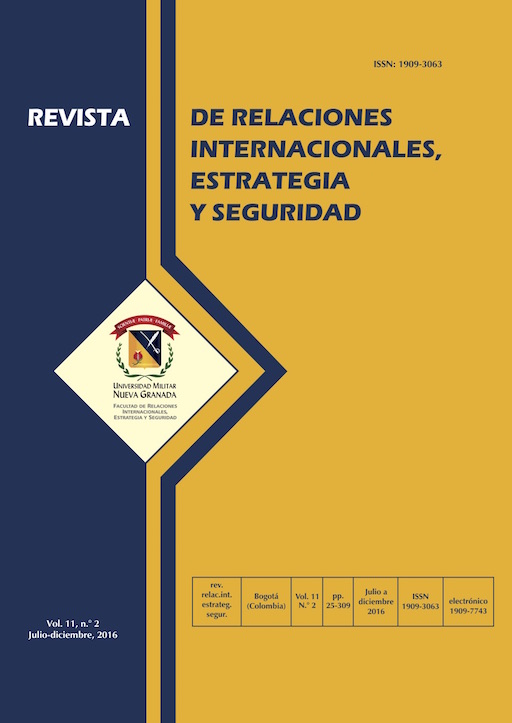As relações do golfo depois da "primavera árabe" e seu impacto na região
Resumo
A "Primavera Árabe" não só teve um impacto a nível local, sacudindo os países diretamente afetados, mas também teve um impacto sobre as relações regionais. Neste contexto, Arábia Saudita, Emirados Árabes Unidos e Qatar foram protagonistas de uma forte disputa regional, sobre o papel do Islã político, especialmente dos Irmãos Muçulmanos. O artigo interroga-se sobre as condições de possibilidade e efeitos dessa disputa, com a intenção de realizar uma revisão exploratória dela através de uma leitura não-sectária dos conflitos após a "Primavera Árabe". Assim, no contexto da intensificação da participação crescente do intervencionismo na política internacional, a ausência de uma comunidade de segurança entre os países analisados levou-os a resolver os seus conflitos através de guerras proxynos diferentes contextos nacionais. Nestes, Doha apoiou os vários ramos do mencionado grupo, enquanto Riad e Abu Dhabi deram apoio ás forças opostas a ele. Assim, o artigo conclui que a disputa entre esses países contribuiu à exacerbação e ao aprofundamento dos vários conflitos nos países afetados pelas revoltas.Downloads
##plugins.generic.ArticleMetadataByBiteca.languages##:
esReferências
Abbink, J. (2003). Ethiopia—Eritrea: Proxy Wars and Prospects of Peace in the Horn of Africa. Journal Of Contemporary African Studies, 21(3), 407-426.
Abdullah, A. (2012). Repercussions of the Arab Spring on GCC States (1st ed.). Doha: Arab Center for Research and Policy Studies.
Adler, E., & Barnett, M. (1998). Security Communities. Cambridge, UK: Cambridge University Press.
Ahmed, A. (2015, 17 de junio). Obama Brokered a Secret Deal Between 2 Arab States that Could Help End Libya’s Civil War. The Huffington Post. Recuperado de http://www.huffingtonpost.com/2015/06/17/libya-peace-uae-qatar_n_7605898.html
Al-Arabiyya (2012, 25 de mayo). Islamists Plot against Gulf, Says Dubai Police Chief. Recuperado de https://english.alarabiya.net/articles/2012/03/25/203019.html
Al-Thani, T. (2013, 26 de junio). HE Tamim Speech. Recuperado de http://www.usqbc.org/uploads/files/NEW1_H_Tamim_Speech_2013(3).pdf.
Amirah Fernández, H. (2011). Relaciones internacionales del Golfo: intereses, alianzas, dilemas y paradojas. Revista ARI, (48), 1-7.
Amirah Fernández, H., & Fernández Gómez, M. (2015). El Golfo y su creciente intervencionismo en Oriente Medio. Revista Elcano, (7), 58-65.
Annan, K. (1999, 18 de septiembre). Two Concepts of Sovereignty. The Economist. Recuperado de http://www.economist.com/node/324795
Ashour, O. (2012). Libyan Islamists Unpacked: Rise, Transformation and Future. Brookings Doha Center. Recuperado de http://www.brookings.edu/research/papers/2012/05/02-libya-ashour
Bahrain News Agency (2014, 5 de marzo). Bahrain, Saudi Arabia, UAE Issue Joint Statement. Recuperado de http://www.bna.bh/portal/en/news/606640
Bar-Siman-Tov, Y. (1984). The Strategy of War by Proxy. Cooperation And Conflict, 19(4), 263-273.
Burke, E. (2012). ‘One Blood and One Destiny?’ Yemen´s Relation with the Gulf Cooperation Council. Kuwait Programme on Development, Governance and Globalization, London School of Economics, Research paper.
Buzan, B. y Hansen, L. (2009). The Evolution of International Security Studies. New York: Cambridge University Press.
Cuadro, M. (2013). Guerra y liberalismo. Revista Relaciones Internacionales, 22(44), 15-40.
Dagher, S.; Levinson, C. y Coker, M. (2011, 17 de octubre). Tiny Kingdom’s Huge Role in Libya Draws Concern. The Wall Street Journal. Recuperado de http://www.wsj.com/articles/SB10001424052970204002304576627000922764650
Deutsch, K. et al. (1957). Political Community and the North Atlantic Area: International Organizations in the Light of Historical Experience. New Jersey: Princeton University Press.
Deutsch, K. (1964). External Involvement in Internal Wars. En H. Eckstein, Internal War: Problems and Approaches (1st ed., pp. 100-110). New York: Free Press of Glencoe.
Dorsey, J. (2013, 8 de septiembre). Wahhabism vs. Wahhabism: Qatar Challenges Saudi Arabia. Middle East Online. Recuperado de http://www.middle-east-online.com/english/?id=61189
Dorsey, J. (2014, 2 de octubre). Gulf Proxy War: UAE Seeks to Further Damage Qatar´s Already Tarnished Image. Daily News Egypt. Recuperado de http://www.huffingtonpost.com/james-dorsey/gulf-proxy-war-uae-seeks_b_5898246.html
Duner, B. (1981). Proxy Intervention in Civil Wars. Journal Of Peace Research, 18(4), 353-361.
Foley, S. (1999). The UAE: Political Issues and Security Dilemmas. Middle East Review Of International Affairs, 3(1), 25-45.
Foucault, M. (2004). Securité, Territoire, Population. Paris: Gallimard.
George, J., & Campbell, D. (1990). Patterns of Dissent and the Celebration of Difference: Critical Social Theory and International Relations. International Studies Quarterly, 34(3), 269-293.
Hajri, R. (2014, 5 de agosto). UAE Tries to Scuttle Qatar-Saudi Reconciliation. Al-Monitor. Recuperado de http://www.al-monitor.com/pulse/originals/2014/08/saudi-qatari-rapprochement-uae-threat-gulf-reconciliation.html
Hearst, D. (2014, 2 de octubre). Was the UAE Behind the Houthi Takeover of Sana’a? Middle East Monitor. Recuperado de http://www.middleeasteye.net/news/was-uae-behind-houthi-takeover-sanaa-1340168724
Hearst, D. (2015, 1 de enero). A Saudi Palace Coup. The World Post. Recuperado de http://www.huffingtonpost.com/david-hearst/a-saudi-palace-coup_b_6531246.html
Hegghamer, T. (2004). Saudi Arabia Backgrounder: Who are the Islamists? ICG Middle East Report, (31). Recuperado de http://www.crisisgroup.org/en/regions/middle-east-north-africa/iraq-iran-gulf/saudi-arabia/031-saudi-arabia-backgrounder-who-are-the-islamists.aspx
Hurd, E. S. (2008). The Politics of Secularism in International Relations, New Jersey: Princeton University Press.
International Commission on Intervention and State Sovereignty,. (2001). The Responsibility to Protect. Toronto: Canadian Ministry of Foreign Affairs.
Janardhan, N. (2013). Regionalisation and Omni-balancing in the Gulf. En A. Echagüe, The Gulf States and the Arab Uprisings. (1st ed., pp. 25-34). Cambridge: Fride and Gulf Research Center.
Kamrava, M. (2012). The Arab Spring and the Saudi-Led Counterrevolution. Orbis, 56(1), 96-104.
Karouny, M. (2013, 31 de mayo). Saudi Edges Qatar to Control Syrian Rebel Support. Reuters. Recuperado de http://www.reuters.com/article/us-syria-crisis-saudi-insight-idUSBRE94U0ZV20130531
Katzman, K. (2014). The United Arab Emirates (UAE): Issues for U.S. Policy. Washington: Library of Congress.
Khalaf, R. y Fielding, S. (2013, 16 de mayo). Qatar Bankrolls Syrian Revolt with Cash and Arms. Financial Times. Recuperado de http://www.ft.com/intl/cms/s/0/86e3f28e-be3a-11e2-bb35-00144feab7de.html#axzz40EhHnWFu
Khalid Hassan, I. (2015). GCC’s 2014 Crisis: Causes, Issues and Solutions. Doha: Al-Jazeera Center for Studies.
Megrisi, T. (2013, 9 de agosto). Libya´s House of Cards. Muftah. Recuperado de http://muftah.org/libyas-house-of-cards/#.VsG5svnhDcs
Muslimi, F. (2013, 20 de agosto). Qatar Encroaches on Saudi Influence in Yemen. Al-Monitor. Recuperado de http://www.al-monitor.com/pulse/originals/2013/08/qatar-encroaches-saudi-influence-yemen.html
Noaimi, A. (2012, 15 de octubre). Setting the Record Straight on Al-Islah in the UAE. Al-Monitor. Recuperado de http://www.al-monitor.com/pulse/originals/2012/al-monitor/uae-setting-the-record-straight.html#
Qatar Ministry of Foreign Affairs (2014). HE Qatari FM: Qatar Chooses Not to Remain on the Fringe of History. Recuperado de http://www.mofa.gov.qa/en/SiteServices/MediaCenter/News/Pages/News20140310215454.aspx
Qatar News Agency (2014, 5 de marzo). Qatar’s Cabinet Regrets Withdrawal of Ambassadors of Saudi Arabia, UAE and Bahrain from Doha. Recuperado de http://www.mofa.gov.qa/en/SiteServices/MediaCenter/News/Pages/News20140305171653.aspx
Rashed, A. (2013, 18 de agosto). Why is the Gulf divided over Egypt? Al-Arabiyya. Recuperado de http://english.alarabiya.net/en/views/news/middle-east/2013/08/18/Why-is-the-Gulf-divided-over-Egypt-.html
Rasheed, M. (2015, 2 de octubre). Saudi War in Yemen Impossible to Win. Al-Monitor. Recuperado de http://www.al-monitor.com/pulse/originals/2015/10/saudi-arabia-lose-protracted-war-yemen.html
Salama, S. (2014, 2 de abril). Qatar´s History of Turbulent Relations with the UAE. Gulfnews. Recuperado de http://gulfnews.com/news/uae/government/qatar-s-history-of-turbulent-relations-with-uae-1.1312739
Smith, S. (2004). Britain’s Revival and Fall in the Gulf. New York: Routledge.
Steinberg, G. (2013). Islamism in the Gulf. En A. Echagüe, The Gulf States and the Arab Uprisings (1st ed., pp. 59-68). Cambridge: Fride and Gulf Research Center.
Steinberg, G. (2014). Leading the Counter-Revolution. Saudi Arabia and the Arab Spring, Berlin: SWP Research Center.
Ulrichsen, K. (2013). Domestic Implications of the Arab Uprisings in the Gulf. En A. Echagüe, The Gulf States and the Arab Uprisings. (1st ed., pp. 35-46) Cambridge: Fride and Gulf Research Center.
Ulrichsen, K. (2014). Qatar and the Arab Spring. New York: Oxford University Press.
Verghese, N. (2014, 8 de septiembre). Libya: Where are the Dividing Lines? Al-Jazeera. Recuperado de http://www.aljazeera.com/news/middleeast/2014/09/libya-conflict-militias-dividing-lines-20149871934621546.html
Youngs, R. (2013). Living With the Middle East’s Old-New Security Paradigm. En Echagüe, The Gulf States and the Arab Uprisings. (1st ed. Pp. 15-24). Cambridge: Fride and Gulf Research Center.
Záccara, L., & Saldaña, M. (2015). Cambios y estabilidad política en las monarquías del Golfo tras la Primavera Árabe. Revista CIDOB D'afers Internationals, (109), 177-199.
| Métricas do artigo | |
|---|---|
| Vistas abstratas | |
| Visualizações da cozinha | |
| Visualizações de PDF | |
| Visualizações em HTML | |
| Outras visualizações | |












